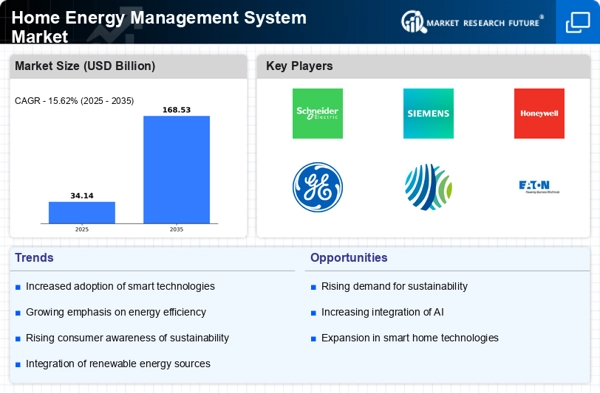Rising Energy Costs
The escalating costs of energy are a primary driver for the Home Energy Management System Market. As consumers face increasing utility bills, there is a growing demand for solutions that can help manage and reduce energy consumption. Reports indicate that residential energy prices have risen significantly, prompting homeowners to seek innovative technologies that can optimize energy use. Home Energy Management Systems provide tools for monitoring and controlling energy consumption, allowing users to identify inefficiencies and adjust usage patterns. This trend is likely to continue as energy prices fluctuate, making energy management systems not just a luxury but a necessity for cost-conscious consumers.
Advancements in Smart Home Technology
The rapid advancements in smart home technology are propelling the Home Energy Management System Market forward. Innovations in Internet of Things (IoT) devices and smart appliances are making it easier for homeowners to integrate energy management systems into their daily lives. These technologies allow for real-time monitoring and control of energy usage, enhancing user experience and efficiency. As more households adopt smart home devices, the demand for Home Energy Management Systems is likely to increase, as these systems provide a centralized platform for managing energy consumption across various devices, thereby optimizing overall energy efficiency.
Government Incentives and Regulations
Government policies and incentives play a crucial role in shaping the Home Energy Management System Market. Many governments are implementing regulations aimed at reducing carbon emissions and promoting energy efficiency. These initiatives often include financial incentives for homeowners who invest in energy management technologies. For instance, tax credits and rebates for energy-efficient appliances and systems encourage adoption. Furthermore, regulations mandating energy efficiency standards for homes are likely to drive demand for Home Energy Management Systems, as these systems help homeowners comply with new requirements while also reducing their overall energy consumption.
Growing Demand for Energy Independence
The desire for energy independence is becoming a significant driver in the Home Energy Management System Market. As consumers seek to reduce their reliance on traditional energy sources, there is an increasing interest in renewable energy solutions and energy storage systems. Home Energy Management Systems facilitate this transition by enabling users to monitor their energy production and consumption, particularly when integrating solar panels or other renewable sources. This trend towards self-sufficiency in energy use is expected to continue, as homeowners look for ways to harness renewable energy and manage their energy needs more effectively.
Increased Awareness of Environmental Impact
There is a growing awareness among consumers regarding the environmental impact of energy consumption, which significantly influences the Home Energy Management System Market. As individuals become more conscious of their carbon footprints, they are increasingly seeking solutions that allow them to reduce energy usage and promote sustainability. Home Energy Management Systems offer features that enable users to track their energy consumption and make informed decisions about their usage. This shift towards environmentally responsible behavior is expected to drive the adoption of energy management systems, as consumers look for ways to contribute to a more sustainable future.

















Leave a Comment